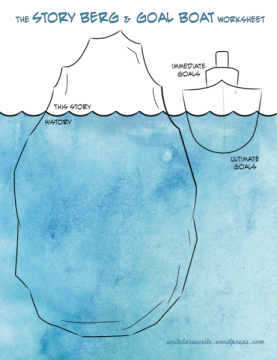This is Part Two in the Write, Edit, Repeat Character Series.
Backstory. What’s backstory?
Backstory is whatever happened to the characters before the story starts. It’s the stuff that the writer knows (or discovers), but what doesn’t show up in the story that the reader is reading.
Backstory is the reason we have Pottermore. Rowling had so much backstory that she could make an entire interactive experience for her readers out of it. An obsessive fan base and millions of dollars to create it doesn’t hurt.
Anyway, the most logical visual for backstory is an iceberg. All the stuff under water might be interesting, in fact, it might be really really good. But if it isn’t absolutely necessary to drive the story forward, then it doesn’t need to appear above water, in the finished piece.
You might be able to squeeze some backstory in under the guise of giving the character depth, but if your editor is making lots of cuts, or your readers are skimming over large chunks, you probably have too much information above water.
What does the reader HAVE TO KNOW? What moves the story FORWARD? These are the events and details to be included in your story. Everything else needs to stay under the water. It can inform you as you write, but if you place too much in the story, it will weigh it down. A reader isn’t going to wait for the story to stop while you talk about the past. Save the backstory for “fun facts” you reveal to die-hard fans after you are published.

How to use the worksheet
Each character has a story and a backstory (what I call history in the worksheet). Write the character’s name on the top of the page, or keep it in a separate section of your notes from other characters’ “Story Bergs.”
Above the water, use bullet points to quickly summarize what happens to the character during the story. For the protagonist, you will probably summarize the 8 C’s. Be as concise as possible. “Runs away” “Falls in love” “BFF dies”
Below the water, use bullet points as well. You can elaborate on these points on the back of the page or in separate notes. Paperclip them to the back of the worksheet or link to them (if using a digital file).
I included goals on here as well, though they do appear in the 8 C’s worksheet. The 8 C’s worksheet is for the overarching plot and usually applies to the protagonist alone. However, each character has his or her own goals. When one character’s goals or desires clash with another’s, you get conflict.
Above the water, you have the character’s superficial or obvious goals. In Tangled, Rapunzel’s superficial goal is to see the lights that float up in the sky every year on her birthday. Below the water, you have the character’s ultimate goals. The ultimate goal needs to be foreshadowed in the beginning of the story (the earlier the better) and throughout the story. Rapunzel’s ultimate goal is to feel wanted, and she discovers her ultimate goal during the Elation.
I have the worksheet available for download in both color and black & white. If you use the color version, use a dark black pen so you can see your notes over the blue water, or else use it in your digital files. I’d recommend using the B&W version for minor characters.
Color Version
Black & White Version



5 thoughts on “Story Berg and Goal Boat: A Lesson in Backstory (and Goals)”